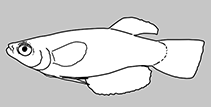Aplocheilichthys spilauchen (Duméril, 1861)
Banded lampeye
Upload your photos and videos
Google imageNo image available for this species;
drawing shows typical species in Procatopodidae.
Google imageNo image available for this species;
drawing shows typical species in Procatopodidae.
Classification / Names Common names | Synonyms | Catalog of Fishes(genus, species) | ITIS | CoL | WoRMS | Cloffa
Teleostei (teleosts) > Cyprinodontiformes (Rivulines, killifishes and live bearers) > Procatopodidae (African lampeyes) > Aplocheilichthyinae
Etymology: Aplocheilichthys: Greek, aploe, -es = simplicity + Greek, cheilos = lip + Greek, ichthys = fish (Ref. 45335).
More on author: Duméril.
Etymology: Aplocheilichthys: Greek, aploe, -es = simplicity + Greek, cheilos = lip + Greek, ichthys = fish (Ref. 45335).
More on author: Duméril.
Environment: milieu / climate zone / depth range / distribution range Ecology
Freshwater; brackish; benthopelagic; pH range: 7.5 - 8.5; dH range: 12 - ?; non-migratory. Tropical; 24°C - 32°C (Ref. 1672)
Distribution Countries | FAO areas | Ecosystems | Occurrences | Point map | Introductions | Faunafri
Africa: from mouth of Senegal River in Senegal (Ref. 47311, 57259) to Cuanza River in Angola (Ref. 120641).
Size / Weight / Age
Short description Identification keys | Morphology | Morphometrics
Dorsal spines (total): 0; Dorsal soft rays (total): 6 - 8; Anal spines: 0; Anal soft rays: 11 - 14. Diagnosis: Larger and deep-bodied ‘Lampeye’ species, slight lateral compression; dorsal fin rounded, anal fin trapezoid, caudal fin truncated; dorsal fin with 6-8 rays, anal fin with 11-14 rays, displacement between dorsal and anal fins 1/7-8; scales on the mid-lateral series 25-28 (Ref. 57259).
Colouration: Male colouration: the basic colour is pale grey-green to olive with a light blue iridescence on the sides; also present on the sides are 10-15 dark grey crossbars which, towards the front break up into spots; the dorsal and anal fins are yellow-green, with grey and silver spots at the base and some grey spots in the posterior parts, arranged into curved bands; the caudal fin is lemon yellow to pale orange with dark grey and silver spots at the upper and lower parts, followed by a narrow orange to red border; the central part of this fin has some curved grey crossbars (Ref. 57259). Female colouration: the body is a translucent silver-grey with a silver abdominal region and lacking the grey crossbars present on the male; all unpaired fins are colourless to pale yellow (Ref. 57259).
Found in brackish water, only rarely entering fresh or marine water (Ref. 57259). Found in coastal swamps, river mouths, lagoons, estuaries and mangrove swamps near beaches (Ref. 3788, 57259). Not a seasonal killifish. Is difficult to maintain in aquarium (Ref. 27139).
Life cycle and mating behavior Maturity | Reproduction | Spawning | Eggs | Fecundity | Larvae
Main reference
Upload your references | References | Coordinator | Collaborators
Huber, J.H., 1996. Killi-Data 1996. Updated checklist of taxonomic names, collecting localities and bibliographic references of oviparous Cyprinodont fishes (Atherinomorpha, Pisces). Société Française d'Ichtyologie, Muséum National d'Histoire Naturelle, Paris, France, 399 p. (Ref. 27139)
IUCN Red List Status (Ref. 130435: Version 2024-2)
Least Concern (LC) ; Date assessed: 01 November 2019
CITES
Not Evaluated
Threat to humans
Harmless
Human uses
Aquarium: commercial
FAO - Publication: search | FishSource |
More information
Trophic ecology
Food items
Diet composition
Food consumption
Food rations
Predators
Food items
Diet composition
Food consumption
Food rations
Predators
Population dynamics
Growth parameters
Max. ages / sizes
Length-weight rel.
Length-length rel.
Length-frequencies
Mass conversion
Recruitment
Abundance
Growth parameters
Max. ages / sizes
Length-weight rel.
Length-length rel.
Length-frequencies
Mass conversion
Recruitment
Abundance
Life cycle
Reproduction
Maturity
Maturity/Gills rel.
Fecundity
Spawning
Spawning aggregations
Eggs
Egg development
Larvae
Larval dynamics
Reproduction
Maturity
Maturity/Gills rel.
Fecundity
Spawning
Spawning aggregations
Eggs
Egg development
Larvae
Larval dynamics
Anatomy
Gill area
Brain
Otolith
Gill area
Brain
Otolith
Physiology
Body composition
Nutrients
Oxygen consumption
Swimming type
Swimming speed
Visual pigments
Fish sound
Diseases & Parasites
Toxicity (LC50s)
Body composition
Nutrients
Oxygen consumption
Swimming type
Swimming speed
Visual pigments
Fish sound
Diseases & Parasites
Toxicity (LC50s)
Human related
Aquaculture systems
Aquaculture profiles
Strains
Ciguatera cases
Stamps, coins, misc.
Aquaculture systems
Aquaculture profiles
Strains
Ciguatera cases
Stamps, coins, misc.
Tools
E-book | Field guide | Identification keys | Length-frequency wizard | Life-history tool | Point map | Classification Tree
| Catch-MSY |
Special reports
Download XML
Internet sources
AFORO (otoliths) | Aquatic Commons | BHL | Cloffa | BOLDSystems | Websites from users | Check FishWatcher | CISTI | Catalog of Fishes: genus, species | DiscoverLife | ECOTOX | FAO - Publication: search | Faunafri | Fishipedia | Fishtrace | GenBank: genome, nucleotide | GloBI | Google Books | Google Scholar | Google | IGFA World Record | MitoFish | Otolith Atlas of Taiwan Fishes | PubMed | Reef Life Survey | Socotra Atlas | Tree of Life | Wikipedia: Go, Search | World Records Freshwater Fishing | Zoological Record
Estimates based on models
Phylogenetic diversity index (Ref. 82804): PD50 = 1.0000 [Uniqueness, from 0.5 = low to 2.0 = high].
Bayesian length-weight: a=0.00977 (0.00325 - 0.02939), b=3.14 (2.90 - 3.39), in cm total length, based on LWR estimates for this (Sub)family-body shape (Ref. 93245).
Trophic level (Ref. 69278): 3.3 ±0.4 se; based on size and trophs of closest relatives
Fishing Vulnerability (Ref. 59153): Low vulnerability (10 of 100).




